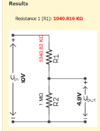Hi,
I'd like to connect 9v battery to the Vin input of the Arduino Uno.
I'd also like observe in code when the battery level reaches below 7.5V so i know it should be recharged.
How can i do it efficiently without consuming too much power from the battery?
I thought maybe using two large equal resistors, connected in parallel to the battery, and connect the point between the two resistors to the Arduino Uno ADC input.
Would you suggest a more elegant way?
Thanks a lot.
I'd like to connect 9v battery to the Vin input of the Arduino Uno.
I'd also like observe in code when the battery level reaches below 7.5V so i know it should be recharged.
How can i do it efficiently without consuming too much power from the battery?
I thought maybe using two large equal resistors, connected in parallel to the battery, and connect the point between the two resistors to the Arduino Uno ADC input.
Would you suggest a more elegant way?
Thanks a lot.


